This is a guest post by educator and VoiceThreader, Eleanna Liscombe.
I am a 12 year veteran teacher of third graders as well as a Google and eMINTS Certified Educator. I earned my Master’s of Information Science and Learning Technology from Mizzou where my studies ignited a new passion. After realizing that I rarely had my students use technology for reaching outside our classroom walls, I decided it was time to open the world to my kiddos from the Midwestern USA.
After meeting Viktoriia from Ukraine via the ePals website in 2014 and chatting via their email exchange, we decided to branch out. She did not have Internet in her classroom but was willing to invite her students into her home to use her DSL connection to create a VoiceThread project and type their comments. Talk about dedication! So, I started a free trial account and had my students create a project on our temperate forest ecosystem in Missouri. I chose this to parallel our curriculum units on the human impact on nature and informational writing. During the course of this I became acquainted via ePals with Dhanam from India whose students from her all girls school also produced a project about their ecosystem. My students were beyond impressed when they learned that their class field trip was TO A RAINFOREST!
After communicating separately with each of my newfound colleagues via ePals we decided to move to a group chat in Google Hangouts. The time difference as well as connectivity issues prohibited a live video chat to solve the issues we were experiencing when trying to access each other’s projects. I used Screencast-O-Matic to make a tutorial and sent it via YouTubeto them. Within a day, we had our very own Group in VoiceThread and all of our students could view and comment on each other’s work.
My classroom was a flurry of excitement as students rolled in each morning itching to check to see if they’d received any “comments” back from their now dubbed Global Buddies. Since then we’ve added our friends in Ghana to the VoiceThread group and await their first contribution. My foreign friends and I all enjoy the authentic practice our students get writing and speaking English while supporting our curriculum and widening our appreciation of the world’s cultures.
We’ve done projects on civil rights, currency, cuisine and holidays. My school has adopted the Odumase Extension School in Ghana and we now fund their annual Internet access fees and purchased a projector for their computer lab last year. This year we hope to provide enough money to purchase tables and chairs for their library that now consists of only a few shelves of books.
I hope you decide to take the first step to break down your classroom walls…I promise your students will benefit from it!
About the author:
Eleanna Liscombe is a third grade teacher who is passionate about using technology to educate her American students about the world. Call it 21st Century Skills, ISTE standards or local curriculum…she is dedicated to creating contributing and successful members of the global community. She holds a Master’s Degree in Information Science and Learning Technology, eMINTS and Level 2 Google Certifications and enjoys teaching fellow educators about the power of technology in education as an adjunct professor for Lindenwood University. If you’d like to follow Eleanna on her journey around the globe, find her on Twitter @elfvdb or read her blog.
This is a guest post by educators and VoiceThreaders, Kelly Riley, Jeff Williams, and Stacey Zawisza.
Students + VoiceThread + Kindness = one wholehearted experience. The Great Kindness Challenge (GKC) is a global initiative where participating schools all over the world devote one week, January 25-29 of the current year, to reinvigorate their campus with a kindness driven culture. The J.W. Reason Elementary counseling department’s focus for the week was to provide over 450 students with interactive, hands-on kindness lessons and activities each day. Little did our school leaders know the culmination of the GKC week, along with student passion, created for countless, unifying experiences. Here is one of those unforgettable experiences with the collaboration of VoiceThread.
During the Great Kindness Challenge Week, first grade students in Mrs. Zawisza’s class participated in many discussions about how to spread kindness. After reading several mentor texts about kindness, and watching a virtual counseling lesson by Mr. Williams, students engaged in conversations about ways that they currently show kindness at school and at home. Once the students had shared their ideas, they were able to write and illustrate a piece about how they show kindness. This piece was used as a template to integrate VoiceThread into the kindness project.
With the assistance of Mrs. Riley, the technology integration teacher, the first grade students in Mrs. Zawisza’s class used VoiceThread to take webcam photos of themselves holding their drawings and writing about how they are kind. Next, the students used the voice commenting feature to record themselves reading their work aloud for their classmates to hear. Finally the students shared their VoiceThread with their class group. This allowed everyone in the class, even non-readers to hear and understand their friends’ work. When each student finished recording their own work, they were able to listen to their friends’ VoiceThreads.
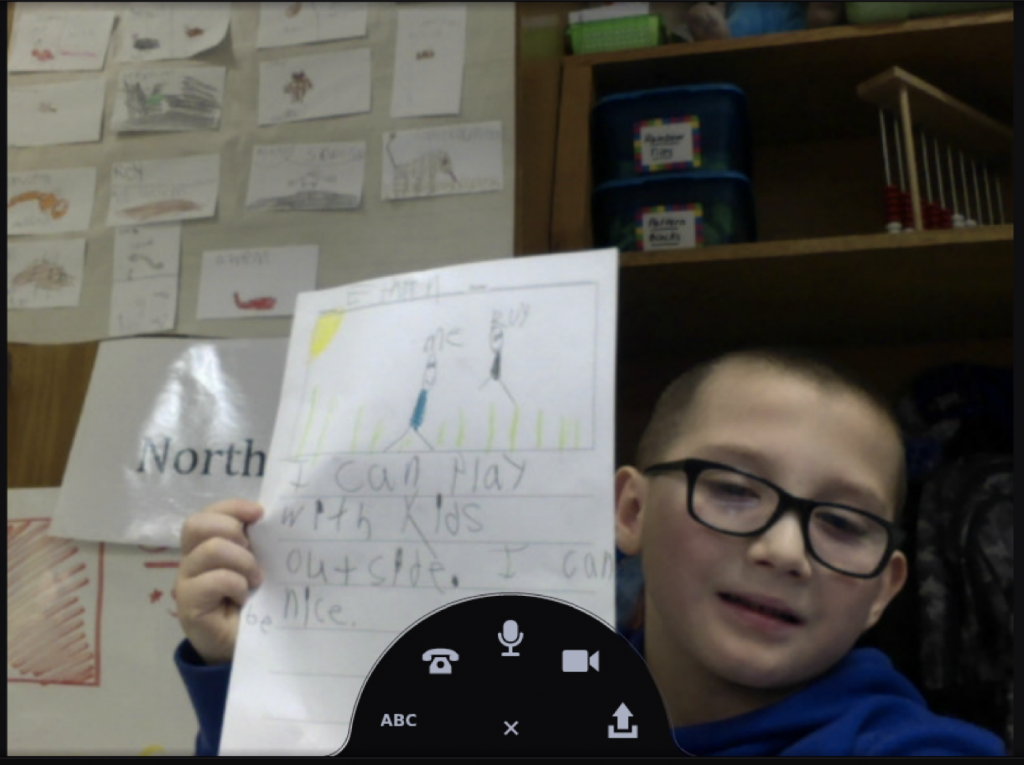
The next part of the Kindness Week learning was about how to comment on others’ VoiceThreads. Mrs. Zawisza showed the students a great video about How to Compose a Quality Comment. This video is about commenting on a blog, but the tips easily transfer to VoiceThread. Mrs. Zawisza led the class in creating an anchor chart of tips for the students to refer to when they were ready to comment on one another’s VoiceThreads.
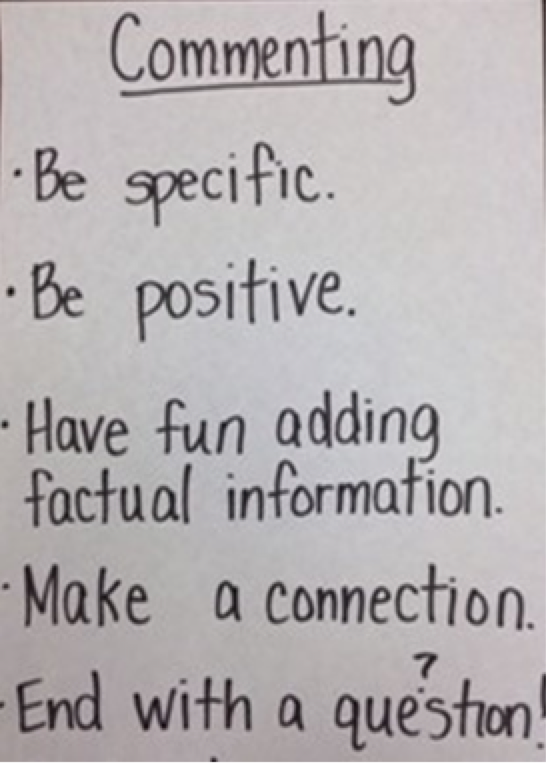
With one student’s kindness VoiceThread projected for the whole class to see, the students practiced making comments orally. They discussed whether or not it was a high quality comment so that they understood how to make a comment that contributes to the conversation. Talking it through before jumping into the technology was a great way for the students to practice their commenting and get feedback from Mrs. Zawisza and from each other.
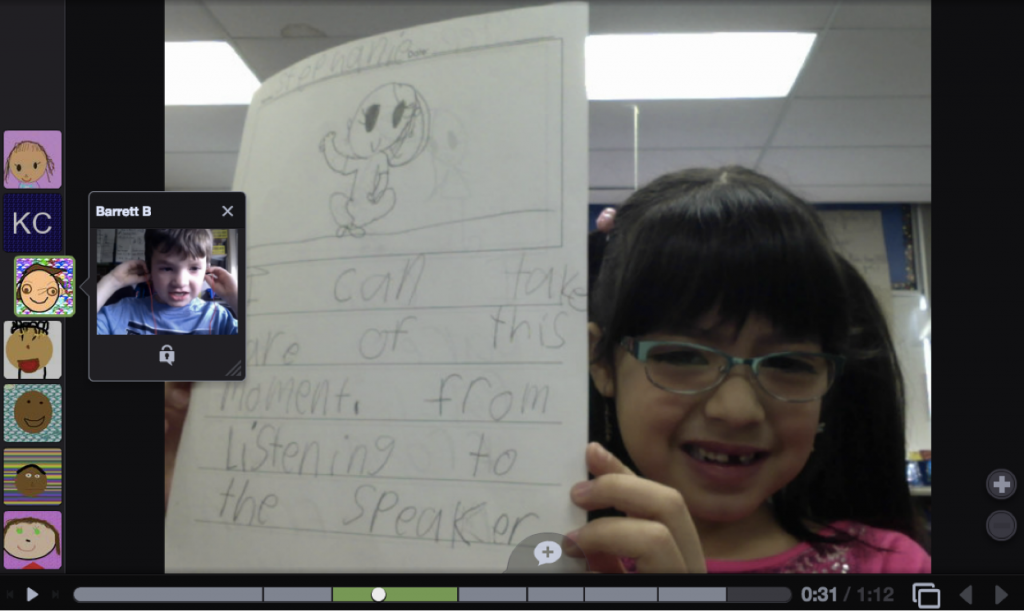
The final step of the project was for the students to record quality comments. The students had so much fun recording audio and video comments on each other’s VoiceThreads. They made personal connections to other students’ work, asked follow up questions, and affirmed how they are kind not only during GKC week, but every day! It was an amazing experience for the students to practice their VoiceThread skills and to connect with their classmates.
About the authors:
Kelly Riley (@klsriley) is a technology integration specialist and VoiceThread Certified Educator. Kelly is passionate about co-teaching and providing professional development for educators to find awesome ways to use technology to help students interact with their world. Jeff Williams (@JAWsclcounselor) is a licensed school counselor. Jeff is driven to passionately incorporate student counseling standards in classroom activities, while promoting a safe environment to have meaningful discussions on the importance of mental health counseling in schools. Stacey Zawisza (@zawisza1stgrade) is a first grade teacher. Stacey enjoys collaborating with other teachers to provide many opportunities for her students to learn and grow as students and as individuals. Kelly, Jeff, and Stacey work together at J. W. Reason Elementary in the Hilliard City Schools in Hilliard, OH.

VoiceThread and LitWorld are teaming up to bring you a new way to participate in World Read Aloud Day! Every year, classrooms around the world celebrate literacy education and this year you can share your love of reading with the world.
Here’s how your class can join the fun:
Getting Started
Play this thread to watch the tutorial:
Written Instructions:
If you don’t already have a VoiceThread account, you can register for a free trial account here: https://voicethread.com/register
Sign in to voicethread.com with your username and password.
Think about what you would like to create. Here are a few ideas:
-You can upload pictures of a book and record audio over each picture as you read aloud.
-You can upload a PDF or PPT slide with your favorite passage and record a webcam comment discussing your thoughts.
-You can simply record yourself reading the book via webcam and invite others to join the conversation by leaving their own comments about the book.
-You can record each student reading a page from the book via webcam and add analysis of the major themes in the book.
-You can upload a movie file of the author being interviewed, or create a book trailer video and begin a conversation with an audio or webcam comment.
Creating your VoiceThread
Once you know what you’d like to do, you can create a new VoiceThread from any VoiceThread page by clicking on the “Create” button at the top.
Click Add Media.
Click “My computer” if you’re going to upload pictures, documents or other files.
Click “My webcam” if you’re going to record from your webcam.
If you chose “My Computer” and you uploaded files, you’ll want to record your comments next. You can do that by clicking on comment:
 That will open your VoiceThread in our media player. To record your comments, click on the plus sign in the comment bubble:
That will open your VoiceThread in our media player. To record your comments, click on the plus sign in the comment bubble:
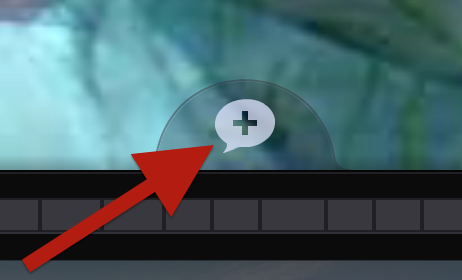 Choose your commenting method:
Choose your commenting method:
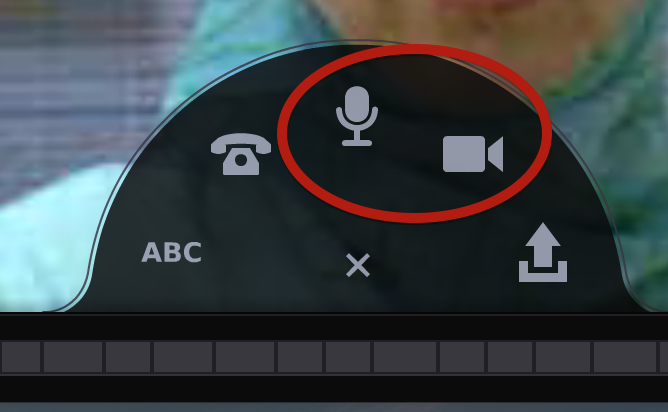 When you are finished recording your comment, click “stop recording”. You can then hear your comment playback and save or re-record it.
When you are finished recording your comment, click “stop recording”. You can then hear your comment playback and save or re-record it.
Submitting it to the ThreadBox
When your VoiceThread is ready to share, you’ll need to copy the link to add it to the ThreadBox
Go to LitWorld’s blog to find the ThreadBox and click “submit your own”:
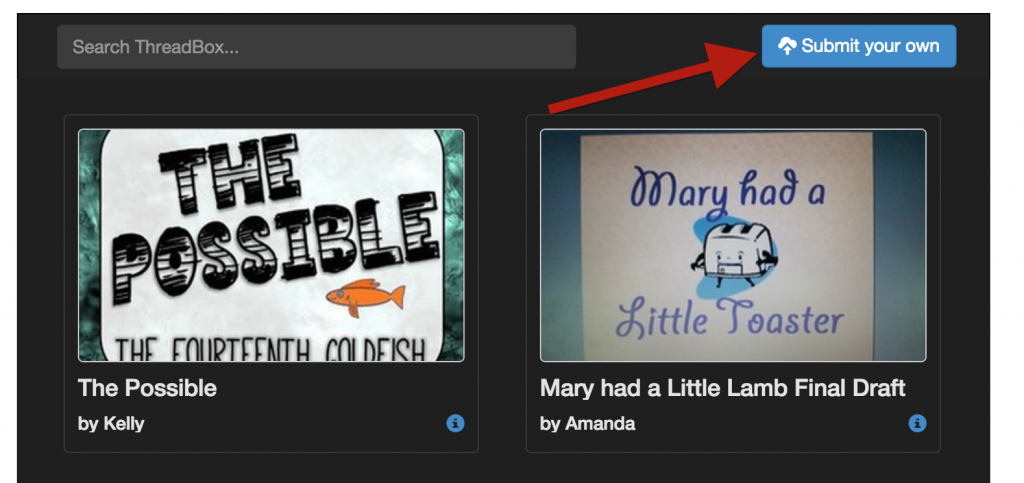
Paste the link and click “submit link”:
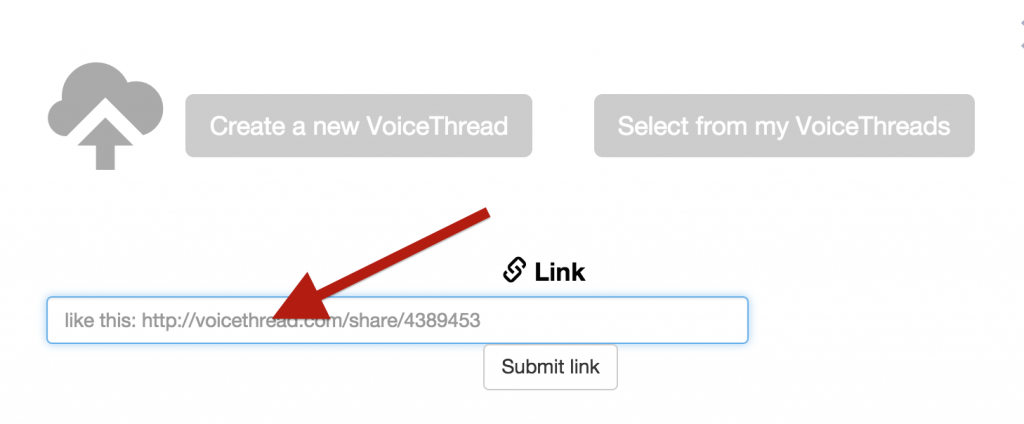 You can also leave comments on any of the VoiceThreads you see in the ThreadBox. Simply click on the play button to open them, then click on the comment bubble like you did for your own VoiceThread.
You can also leave comments on any of the VoiceThreads you see in the ThreadBox. Simply click on the play button to open them, then click on the comment bubble like you did for your own VoiceThread.
If you have any questions or want to see some examples of what you can create with your students, join us for one of our free workshops:
Monday, February 8th, 4pm ET: Register
Wednesday, February 10th, 12pm ET: Register
We hope your class can join in the fun and share their love of great books!
This is a guest post by educator and VoiceThreader, Marleah Jacobson.
VoiceThread meets Deaf education and magic happens. Magic in the form of a classroom erupting with language; both English and American Sign Language.
Once the Deaf and hard of hearing students in my 3rd-5th grade classroom have the chance to respond to questions, process new material and express their ideas in a language that is fully accessible due to its visual nature–American Sign Language–I see marked growth in their abilities to understand and produce written English.
When I first learned my Deaf education class would receive a Chromebook for each student and access to myriad learning resources as part of a blended learning technology program for the 2015-2016 school year, I was excited about the possibilities. I made a list of all the ways we could utilize technology to increase opportunities for students’ to save and share ideas in American Sign Language. VoiceThread has been the greatest resource in helping us do just that.
By no means an extensive list, this is the top five ways we are using VoiceThread in the Deaf Education classroom to give Deaf and hard of hearing students opportunities to use both American Sign Language and English.
1. To demonstrate learning through interactive presentations.
With VoiceThread’s picture import feature, students were able to find pictures from Flickr and New York Public Library to fit their “Natural Disaster” topic. Students then made videos to describe their natural disaster, its causes and the effects. Students also included an ASL poem in their presentation about their natural disaster. In the closing slide, students asked a question about their natural disaster. Using the share feature, students were able to view and comment in both English and ASL on other student’s presentations. Students then answered the question at the end of a classmate’s VoiceThread presentation.
See the example VoiceThread below on the topic of “Tsunamis.” The student’s facial expressions say it all: she was highly engaged in her learning!
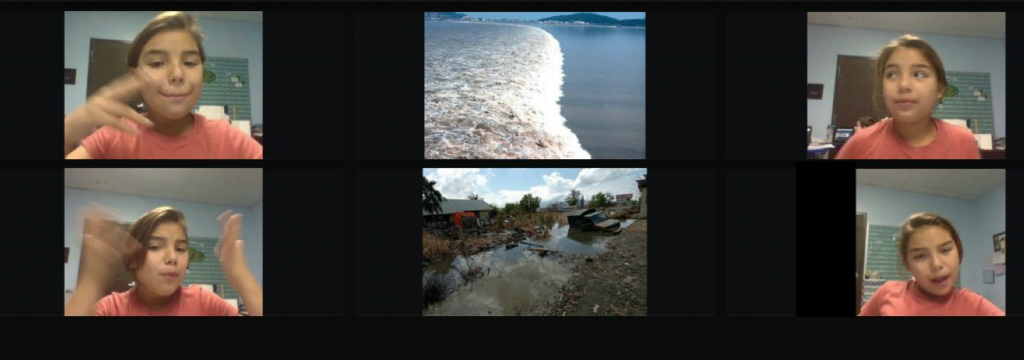
2. To make all students math teachers.
Because VoiceThread allows for image uploads, I can easily post any math problem in a VoiceThread slide. Not only can I record a video of myself demonstrating how to solve the problem, but I can have students show their grasp of a math concept by teaching a problem on a VoiceThread slide. They can video themselves explaining the concept in ASL and use VoiceThread’s draw feature to solve the problem and therefore demonstrate their understanding. This experience is invaluable as learning becomes very permanent when they have to explain the concept.

3. To be reading detectives, using text-based evidence to support answers.
Getting students to find text-based evidence to support their answers can be a challenge, but using VoiceThread I can ask the question in both English and ASL which helps the students really understand what is being asked.
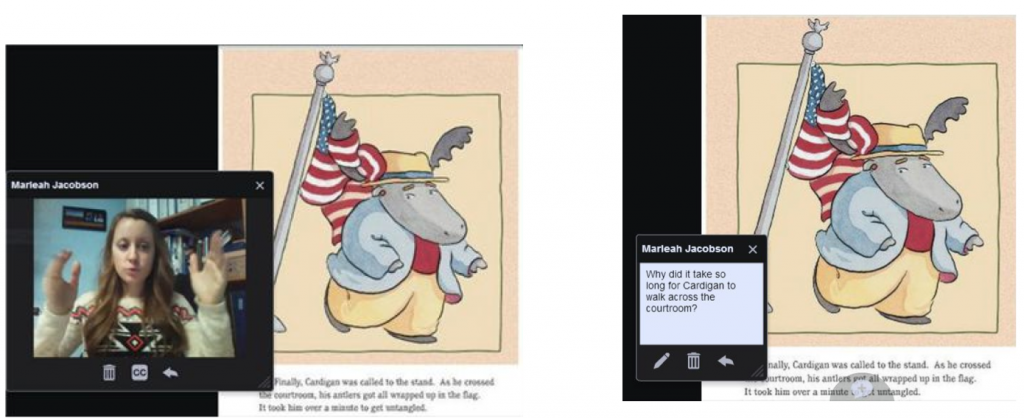
Next, students have the opportunity to record themselves signing their answer as well as underline the evidence in the text. Because all this has been recorded, we can look back at the answer they signed and the text they underlined to make sure it fits the question. Students also have the opportunity for peer revision and correction, and the chance to see how other students answer the question. Because students are so motivated to use VoiceThread, they are more open to redoing their work, deleting a video and starting over if their first answer was off-topic. It’s been amazing to see their progress as they really look at what the question is asking and how the text can be used to find the answer.
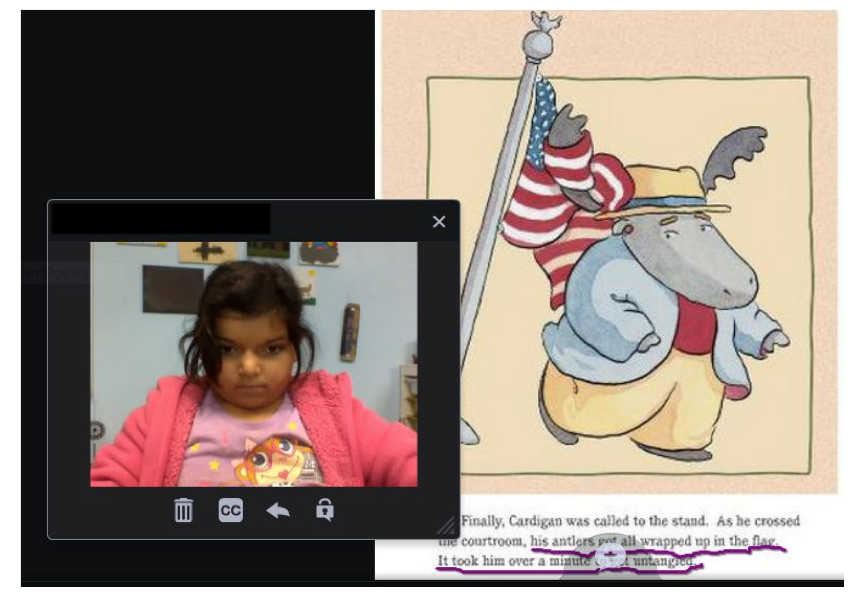
4. To enforce no “opt out” in class discussions.
Many software programs have the ability to revolutionize the classroom by providing opportunities for real-time collaborative discussion. But only VoiceThread gives my students the chance to answer a question in either English or ASL (or both!). With VoiceThread I can pose a question to the class either in the moment or by sharing a pre-recorded VoiceThread with them. This way I can also expose the students to both the English and ASL form of the question. Then students have the opportunity to answer in English or ASL, and I can show the class all or some of the answers. It’s low-risk for the students because I may or may not show their answer, but they don’t have the option of not participating.

5. To make history come alive and heartfelt.
Just today my students spent some time reflecting and learning about Dr. Martin Luther King Jr. and the Civil Rights Movement. A lot of emotions and shock came up as they learned about historical events. Following the discussion, students had the opportunity to sign a “letter” to Dr. Martin Luther King, Jr., giving him the words of encouragement they would have shared if they were alive during the Civil Rights Movement.
We’re only touching the surface on ways to use VoiceThread in the classroom. Our next project is to make interactive signed storybooks of the students’ own writing. I can’t wait to see them able to sign their scanned stories and give each other English and ASL feedback! Being able to honor both English and ASL in the classroom, and seeing my students excitement and confidence grow are two great reasons to keep exploring VoiceThread.
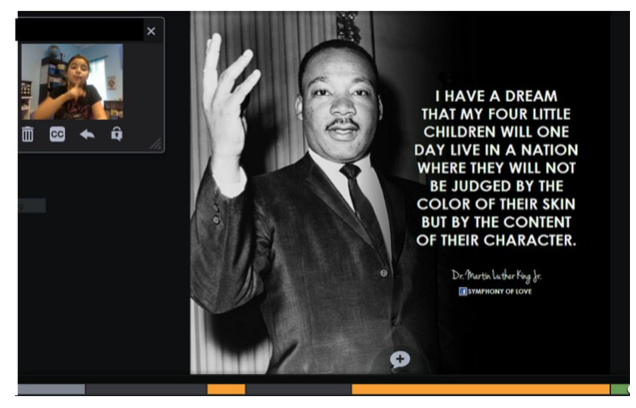
About the author:
Marleah Jacobson is in her 3rd year as an elementary teacher at the Sequoia School for the Deaf and Hard of Hearing in Mesa, AZ in the heart of cactus land. She is passionate about literacy and enjoys seeing the ways technology can spur learning.
Are you looking for ways to empower your students to be more creative? Picture books are a great way to bring your students’ imaginations into your curriculum.

At VoiceThread, we think every student should be heard, but with the time constraints of a class period, not every student has that chance. Why not let them each record their version of a story in one of the picture books that you use with them? Imagine uploading pictures of the book’s pages, then asking your students to use their imagination and record their interpretation of the images that tell the story. Better yet, imagine working with the art teacher to have the students draw their own versions of the images in the book first, upload those pictures and then ask them to record their story. If you really want to tap into their imaginations, imagine drawing an original, collaborative picture book and uploading that to a VoiceThread.
Imagine hearing how well they comprehend the visual scenes and assess their visual literacy, hearing how well they pronounce words and how they use them in context. Imagine hearing how different each student’s interpretation can be. Whether you teach early education or advanced foreign language courses at a higher grade level, your students can take an active role in their own language acquisition and find an outlet for their robust imaginations.
Imagine that.
This is a guest post by language educator and VoiceThreader Araceli Trujillo.
Why VoiceThread?
As an online Spanish instructor, I can say that VoiceThread has revolutionized my course design and teaching. VoiceThread is a tool that enables students to practice their listening and conversational skills for language courses in a fun and engaging way. They can listen to dialogues and comment orally on images and videos. VoiceThread allows language teachers to replicate to a certain extent what is done in an in-person classroom. In an in-person classroom, foreign language teachers make constant use of body language, verbal cues and visuals to help students understand better the target language. While this is not always easy to achieve in an online setting, VoiceThread makes it possible. The integration of interactive and engaging storytelling videos enhanced with VoiceThread lesson plans were designed to foster instructor’s presence on the online environment. My instruction through VoiceThread has evolved each semester to a point that I feel it is very effective and rivals or even exceeds the quality of teaching possible in an in-person, traditional classroom setting.
I currently use VoiceThread for my online Spanish classes to create interactive videos portraying body language, gestures, and verbal cues in order to help students better understand meaning. Here is an example using video on VoiceThread to visually provide a set of images to enable the student to understand that I am speaking in Spanish about my physical height. Students are able to visually perceive exactly what I am saying in Spanish because the images on screen are side by side to emphasize that I am speaking from an upright position followed by a second photo in which I actually use the gesture for height.
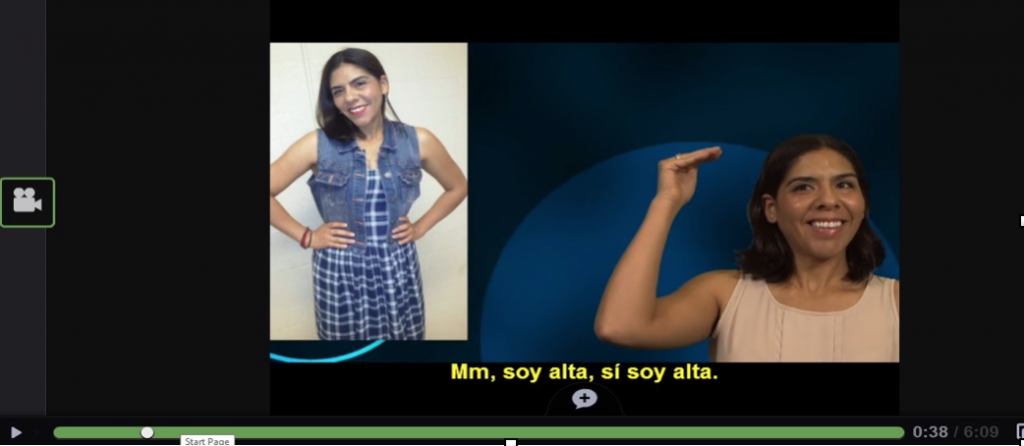
VoiceThread Screenshot #1 instructional video using the verb “Ser” with physical and personality trails.
Early stages of developing lessons with VoiceThread
I was introduced to VoiceThread three years ago during my online teaching certification program. Since then, my course design, lectures, and ways of presenting assignments for students have evolved as I learned more about how to use VoiceThread and make use of its capabilities. I continue to use VoiceThread for my advanced conversation class as an experiment in flipping the classroom by using VoiceThread as a discussion forum. I noticed that students began to participate more after they had the opportunity to reflect, listen and practice the target language on the topics discussed in class. The VoiceThread I created for my elementary courses in my early designs allowed me gradually develop a higher level of confidence with the tools and this opened the door to ways I could design activities that allowed students to practice their pronunciation. Also, the students became proficient at creating their own cultural portfolios for their final presentation (See screenshot #3 for more details about the final presentation).
Here is an example of students’ oral practice activities with VoiceThread in which I ask them to describe themselves physically and to tell me a few things about their personalities using the vocabulary structures learned in class.
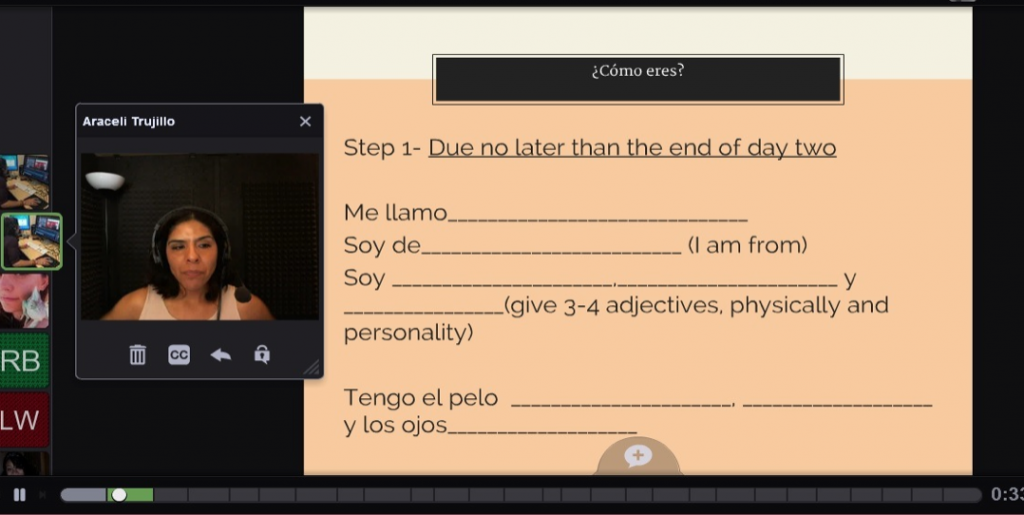
VoiceThread screenshot #2 follow-up oral activity after watching the instructional video
The portfolios for the cultural presentation are based on the research and actual oral presentation of a Spanish speaking country about traditions, customs, music, religion, food, etc. I provide an outline for students on the basic information and samples with ideas on how to deliver their presentation using vocabulary and grammar structures learned in class that promote cultural awareness. Students were required to show the new skills they’ve acquired based on content/research, pronunciation, grammar, quality and visuals.
The final presentation A Cultural Project on South America is an excellent example of how to effectively use VoiceThread. VoiceThread provided a way for the student to show herself presenting on screen and at the same time on the same screen the student is able to provide images to enhance her presentation. In this slide Leetal is describing Peru’s location using the verb “estar” (to be) plus prepositions of place.
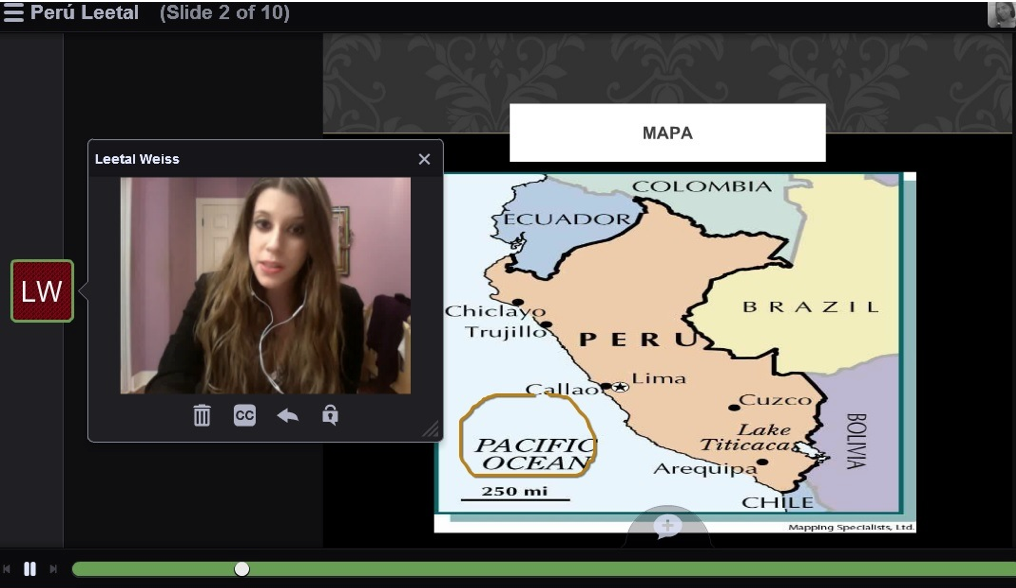
VoiceThread screenshot #3 from a cultural portfolio from Leetal Weiss (shared with student’s permission)
Multidimensional lesson plan on VoiceThread
I now use advanced VoiceThread tools as well as instructional videos as one of the main components of my online instructions. I wanted to capture on video not only course material, but also my personality, teaching style and the sense of humor I add to my lessons. Once I recorded some sample videos on the green screen, my entire lesson plans started to take shape. The use of instructional videos enables me to establish an actual presence as an online instructor by connection students with a humanistic side that sometimes gets neglected on online setting.
I was amazed by the result of my instructional videos and VoiceThread designs that integrated listening comprehension and speaking skills, two of the most challenged skills for language learners. Students began making references about my videos and started using them as a model for their own responses, proof that they understood the storytelling and explanations on the target language. Instructional videos are perfect for language students since they can pause, rewind and replay again.
Here is an example of storytelling with video. In this example, I incorporate vocabulary and grammar structures on my video narrations for listening comprehension skills as well as a model sample for students to use the video as resource for their oral activities on VoiceThread. This video is used to introduce the future tense using visuals aids that enhanced and made it possible for me to make some future predictions about Araceli’s exciting life. This exercise brings to the forefront the point of view of the fortune teller, Crystal. After watching the video, students were instructed to assume Crystal’s role by doing so they were able to create their own predictions while incorporating the structures learned during the module on the VoiceThread oral activities.
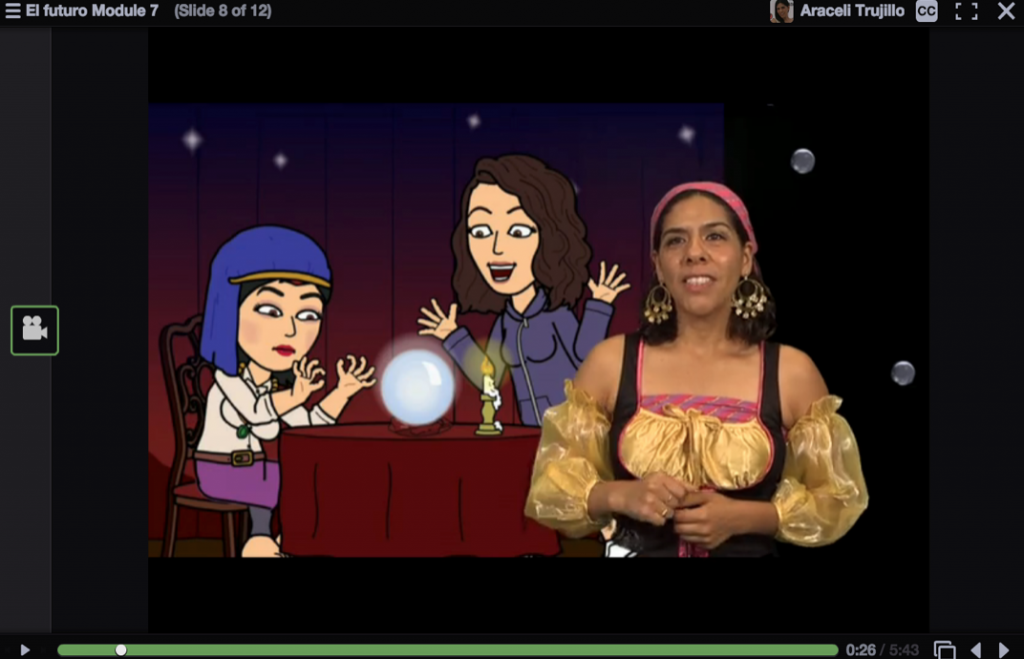
VoiceThread screenshot # 4 I had a blast narrating, acting, editing and producing my videos
I created a total of fifteen VoiceThreads though the semester, all with a similar structure, but with different scenarios. This approach to teaching VoiceThread helps students to have consistency at each steps of the activity in which they are engaged in each module. For example, each week began with a “quick review” using a VoiceThread slide as my “chalk board”, followed by the viewing of one or two instructional videos with the grammar and vocabulary structures learned during that week and oral/listening activities for students to follow as a model for their video/audio responses. Students were also required to listen to their peers’ responses and provide feedback. One of my students noted that listening to her peers with the same level of language experience made the whole process of understanding their oral responses easier. Access the following link that provides a student’s description of this process.
https://www.youtube.com/watch?v=zp_oTrotgX8
Here is an example of one of my “quick reviews”. I used Voicethread for grammar tutorials. I went over the grammatical points that students have the most difficult time learning by breaking down step by step instructions on how to better understand and grasp grammar concepts.
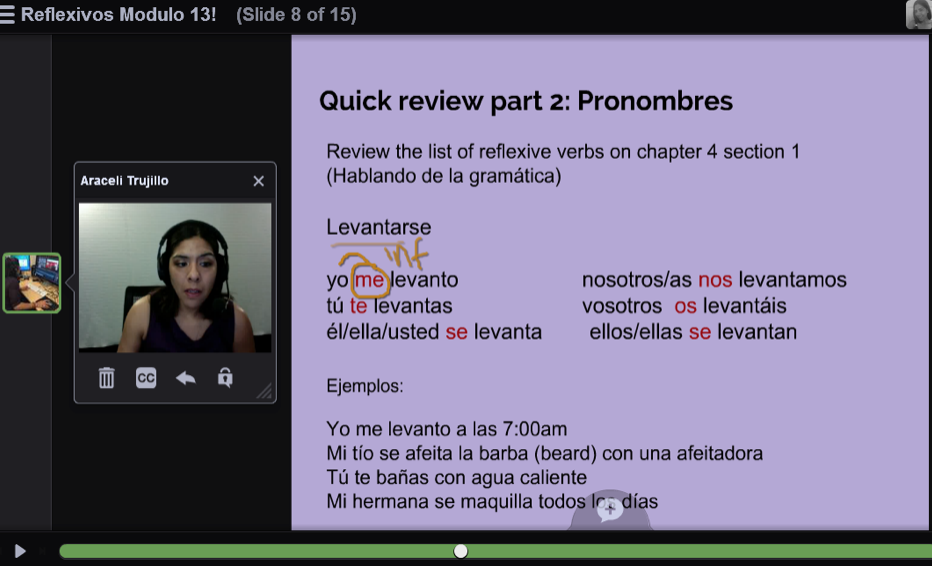
VoiceThread screenshot 5. “Quick review” on Reflexive pronouns
Video instructions create instructor and student presence
Through the experience of teaching Spanish with VoiceThread, I learned so much about my online students, probably more than in my traditional courses since each student was required to participate and leave their voice responses. These lessons have also created a learning community because students have to listen and respond to each other. My elementary Spanish students were engaged in the activities and many of them jumped into VoiceThread as soon as I opened the modules just to watch my videos. One student acknowledged that she felt as if she had come to know some of her classmates’ likes, and dislikes, daily routines, and pastimes based on their responses. I, too, felt this connection with my students and the students were getting to know me though my storytellings, and I was able to also start to get to know them based on their responses. I also collected some feedback from some of my students who described their learning experience based on my instructional videos and activities on VoiceThread. Those comments were shared privately, but I received their permissions to use their comments as part of this project. Their testimonies reinforced my initial thought about the power of instructional videos to create a powerful instructor’s presence in the online class as well as serve as a tool for students to have exposure to listening inputs closer to the ones I provide in my in-person courses ( click this link for samples of Students Feedback).
Evolving as online educator
As an educator I feel that using VoiceThread enables me to both reach many of my professional goals as I continue to add enhancements to improve my already established approach to teaching. One of the things that I deeply love about using VoiceThread in my courses is that I started using the private commenting feature which is transforming the way I am providing feedback about their performance in the oral activities to my students as well as things that they can do to improve. I use the video tool because it encourages and promotes social presence in an online setting. In my personal experience, students tend to reach me in a larger scale when I use video or voice to reach out to them. Also, the threaded commenting is helping the way students comment/reply to each other by addressing directly to the particular student they want to communicate or acknowledge for their comments or feedback. At the same time the thread commenting increases their listening and conversational skills because students have to listen and reply to each other creating asynchronous communication. Therefore, threaded commenting addresses the main reason for learning a new language: to be able to convey meaning and conversation in the target language.
Sample of a private commenting and thread features by Jennifer Hobart: Thank you for all your help in this class!
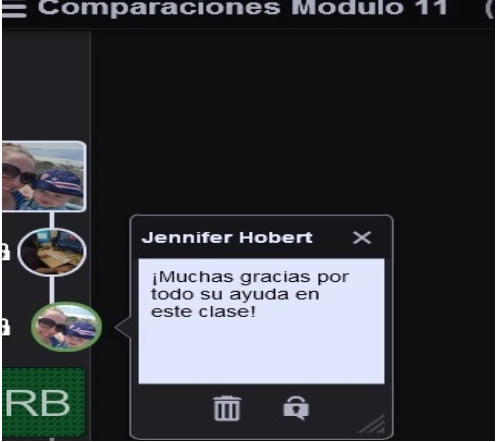
Results and advice
The above proves that by using instructional videos to create instructor’s presence and multidimensional tools in VoiceThread enhance teaching and learning. I understand that for some instructors putting themselves on the camera is not easy, but students appreciate watching their instructors teaching and engaging them through their videos and lessons. Little did I know that my lesson designs in VoiceThread would change so fundamentally the way I teach. I received a great deal of constructive feedback from students about my instructional videos integrated with VoiceThread.
My designs did not happen overnight, and the success of my online course is the result of my experience transforming and innovating my lesson plans over time. Coming up with the stories for the videos and then working around those videos to create the activities on VoiceThread took time and dedication. My advice for those who are new to VoiceThread or are looking for ideas on how to use VoiceThread to enhance student learning, is to create low-risk activities and build up from there so students can feel confident using VoiceThread and video.
Here is one sample of the opinions and reactions about my overall video, VoiceThread activities designs and online teaching.
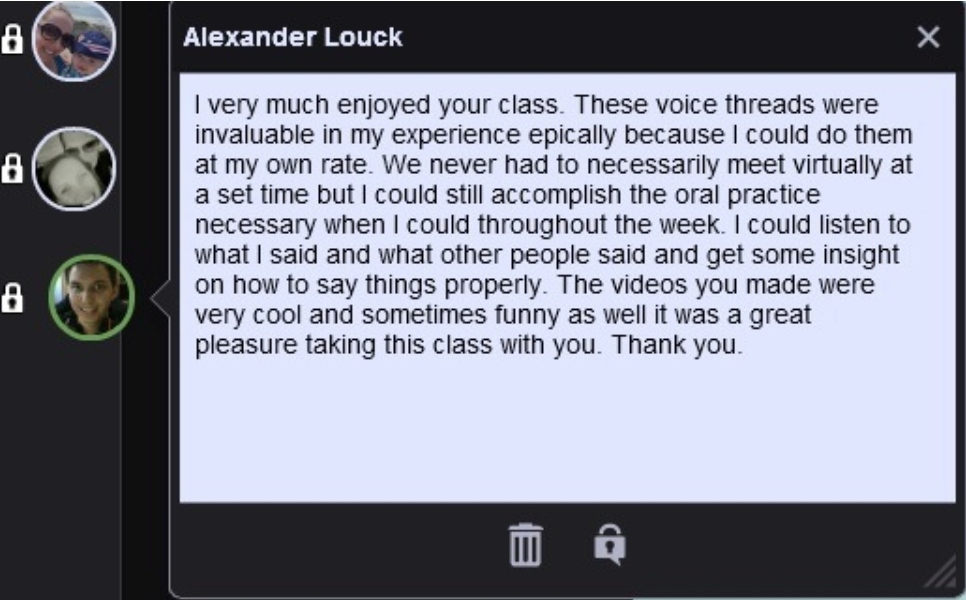
VoiceThread screenshot 7 Student feedback about the use of video and VoiceThread on the online course
I want to thank Michelle Pacansky-Brock who encouraged me and supported me with my online course design and who taught me how to humanize online courses with VoiceThread!
About the guest blogger:
I hold a Master’s degree in Spanish from the University of California, Santa Barbara (2009) and an Online Teaching Certificate from the @One Project funded by the California Community College Chancellor’s Office of Telecommunications (2014). Currently, I am a Lecturer in Spanish at California Lutheran University. My teaching experience also includes employment as a Spanish instructor at the University of California, Santa Barbara, the University of Memphis, and Allan Hancock Community College. At present, I am designing and teaching hybrid and fully online courses and serve as a consultant for hybrid and online instructors on two higher education projects. I truly enjoy teaching, and I am constantly searching for innovative ways in which I can help my students to succeed in my classes. I make it a priority to incorporate creative and relevant material into my curriculum. One way is through the production and editing of my own videos, which enables to me to create educational and engaging materials that bring quality and humanization to online teaching. You can connect with Araceli on Twitter: @TrujilloAraceli.


This is a guest post by Spanish educator and VoiceThreader, Laura K. Sexton, MA/NBCT.
There are three people that need to see my students’ VoiceThread e-portfolios for Spanish: them, me, and everyone else.
E-portfolios help my students watch themselves grow, and VoiceThread allows them to demonstrate that growth in their reading and writing as well as their speaking and listening— something you just can’t do on paper. Portfolios, unlike tests or quizzes, also help me evaluate not just the depth, but also the breadth of each student’s Spanish abilities.
Everyone else needs to see what these young people accomplish, too. My students start off as baby parrots who can only repeat what I say, but by the end of Spanish I, they’re analyzing documents on Latino demographics and marketing their own inventions to Spanish speakers! I’d say that’s worth showing off. With VoiceThread, not only can Mom and Dad see their Spanish feats, but future employers or college professors responsible for placement and/or credit waivers can see actual samples of their writing in the target language as well as video of their actual recitations, conversations, and presentations.
But what if my students make a mistake? Like a really big mistake, one that results in zero college credit or a “Don’t call us, we’ll call you” after the interview?
I have to let my language learners know what to fix, but without destroying their lovely portfolios!
This is where the new VoiceThread feature, private reply to a comment comes in handy! I simply poke the little lock under the erroneous comment, and add my suggestion–and employers, professors, Mom, and Dad are none the wiser! AND my little language learners have what they need to fix their mistakes!
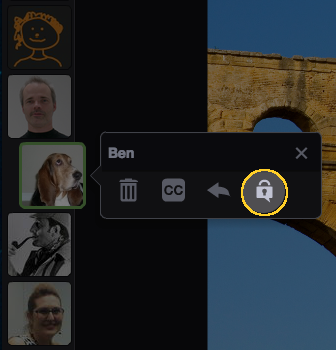
Private replies are an easy solution for my students because they already use VoiceThread comment features in a variety of ways on their portfolios:
- underlining Spanish text in a document, photo, or infograph and recording their interpretation
- adding text to videos indicating the Spanish words, phrases, and sentences they heard and what they mean in English
- adding corrections or explanations for problems on previously submitted assignments
- recording a conversation with a partner by taking turns commenting on an image on a certain topic\
And recording a conversation on VoiceThread just got easier with the new comment features. Now instead of just adding comments all around the uploaded media, my students can create threaded comments. This means that they can even have multiple conversations or interpretations–*that go in order–*on one slide!
It means, too, that I can start a VoiceThread for practice conversations before portfolios and not have to worry about the molasses-level record-upload-wait-submit-download-wait-reupload process we have to go through when submitting videos online with other systems. And then with the new direct reply to a comment feature, I can give each individual feedback to improve their performance before portfolio time!
My students start from nothing in Spanish and develop a lot of amazing skills. VoiceThread commenting makes it easy to help develop those skills, and then to show them off to the world!
About the author:
Laura Sexton is a Spanish teacher at Gaston Early College High School, blogger on PBL in the TL.You can connect with her on twitter here: @SraSpanglish
How do you prevent students from cheating in an online course? We come across a number of posts every week discussing strategies, explaining how students can google answers to multiple choice tests, pay other people to act as them during an online exam and even write papers for them.
When instructors don’t see or hear students during a course, the ability to cheat increases dramatically. Others have come to this same conclusion, but the solutions they promote involve various strategies previously found in books by George Orwell. These strategies usually involve 360 degree webcam monitoring, locking down student browsers, and other ideas born from a dystopian view of education. These ideas are based on flawed assumptions about course and assessment design that may have been true ten years ago but no longer apply today.
Assumption 1: Courses are either face-to-face, human exchanges or online and impersonal correspondences.
Assumption 2: Auto-graded, short answer tests and written papers are the centerpieces of online assessment.
These assumptions may have been true when universities first started their online programs, but now they are relics of the limits imposed by technology decades ago. Technology has changed since the era of the correspondence course, but our mindsets haven’t caught up to these changes.
De-bunking Assumption #1
Most of these academic dishonesty issues arise from anonymity and impersonal course design. In a face-to-face course, student comments are not anonymous and impersonal, but in online correspondence they can be. With VoiceThread, courses can be both online and face-to-face. When students are required to speak up and express their opinions, apply their knowledge, and literally discuss course content instead of typing on a text-based message board, anonymity goes away. Students who cheat in an online course rely on the fact that their instructor doesn’t know their point of view, their style of communicating ideas or their personality. If you are just a student ID on a course roster, it’s easy to copy/paste answers or find someone to type original answers for you in exchange for money. To accomplish this type of cheating in a VoiceThread based course, that student would need to find a look-a-like who had the time to participate and engage in class discussions throughout the semester.
De-bunking Assumption #2
There is nothing intrinsically wrong with short-answer tests or long-form research papers, but they also don’t need to be impersonal and exclusively text-based. When an instructor creates a short-answer test with VoiceThread, they can ask follow-up questions, explore and examine student comments and genuinely assess their understanding. VoiceThread empowers instructors to create assessments that are Google-proof through the use of authentic, human dialogue. Basic facts are the foundation of all higher-order thinking, so knowledge of these facts can be assessed through questions requiring application and synthesis. If a student can Google an answer, the question wasn’t assessing understanding in the first place. In a traditional class, students can cram and temporarily memorize facts which subverts the learning goals the same way Googling an answer does.
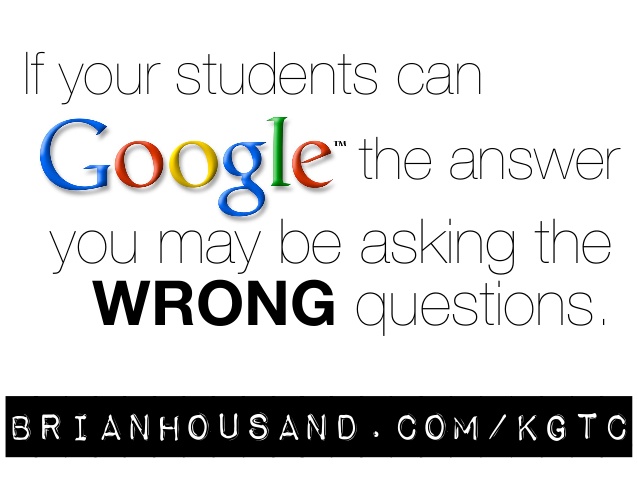
Students can only use a paper-writing service when they are being evaluated solely on the final product. If the instructor never sees the previous drafts, never discusses changes, never probes the evolving concepts with the student, ghost writers have an opportunity to thrive. When students plan, create, and revise over time in a transparent environment like VoiceThread, ghost writers are excluded from the conversation.
The age of the correspondence course is over. Online courses in this decade can be human, relationship-oriented learning experiences and VoiceThread can help.
We recently released 3 new commenting features for our VoiceThreaders to use! Now, instructors can reply directly to students, give private feedback or enable threaded conversations on their content. Here is a breakdown of each new commenting feature.
1. Direct reply to a comment
If you are the owner or editor of a VoiceThread, you are able to insert a comment directly after someone else’s comment on your slide. This allows you to help guide the conversation and give feedback directly to your participants. To do this, click on the direct reply icon inside a person’s comment window.
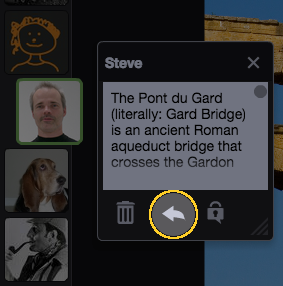
You’ll then see your own Identity image appear as a preview in the conversation channel so you can see where the comment will be inserted, and you’ll see the name of the person to whom you are replying in the comment fan at the bottom of the VoiceThread. Select the option you want to use, and then record your comment normally.
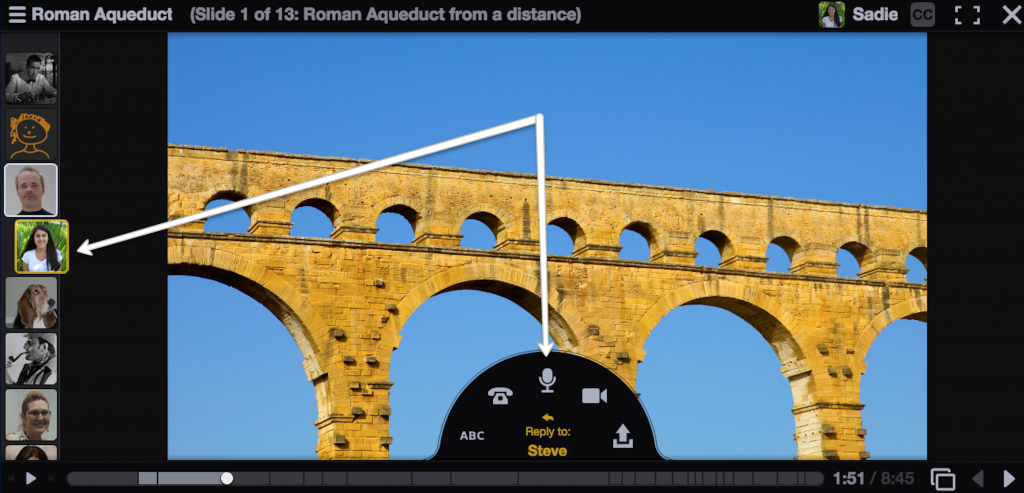
After you have saved your comment, you’ll see that new comment appear in the conversation channel in the correct location.

2. Private reply to a comment
The private reply feature allows you to start a private, two-way conversation with someone who has commented on a VoiceThread. Private comments are represented by a round Identity image with a padlock icon. To start a new private conversation or add to an existing one, click on the private reply button inside a person’s comment window. It looks like a padlock.

You’ll then see your own Identity image appear as a preview in the conversation channel so you can see where the comment will be inserted, and you’ll see the name of the person to whom you are replying in the comment fan at the bottom of the VoiceThread. Select the option you want to use, and then record your comment normally.
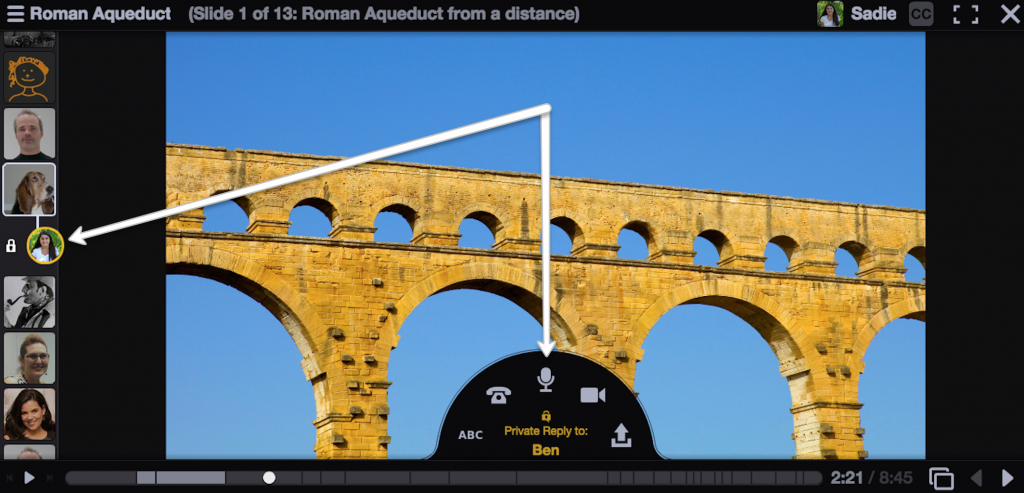
After you have saved your comment, you’ll see that new comment appear in the conversation channel. As you and the other person in your private conversation interact, you’ll see that conversation connected by a white line. No one else will be able to see this conversation.

*Note: *K-12 students are not permitted to private reply to anyone other than teachers in their own school. To disable private commenting for your students, have your VoiceThread Administrator adjust this preference in your Manager Settings.
3. Threaded Comments
If you own a VoiceThread and you are using an upgraded VoiceThread license, you can turn on threaded commenting in your VoiceThread settings. This allows your participants to start a separate comment thread that branches from the main conversation channel. These comments are represented by a round Identity image. To start a new threaded conversation, click on the threaded comment button inside a person’s comment window.
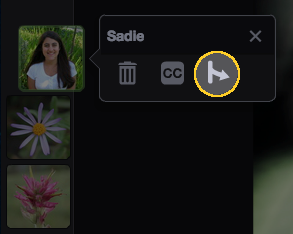
You’ll then see your own Identity image appear as a preview in the conversation channel so you can see where the comment will be inserted, and you’ll see the name of the person to whom you are replying in the comment fan at the bottom of the VoiceThread. Select the option you want to use, and then record your comment normally.
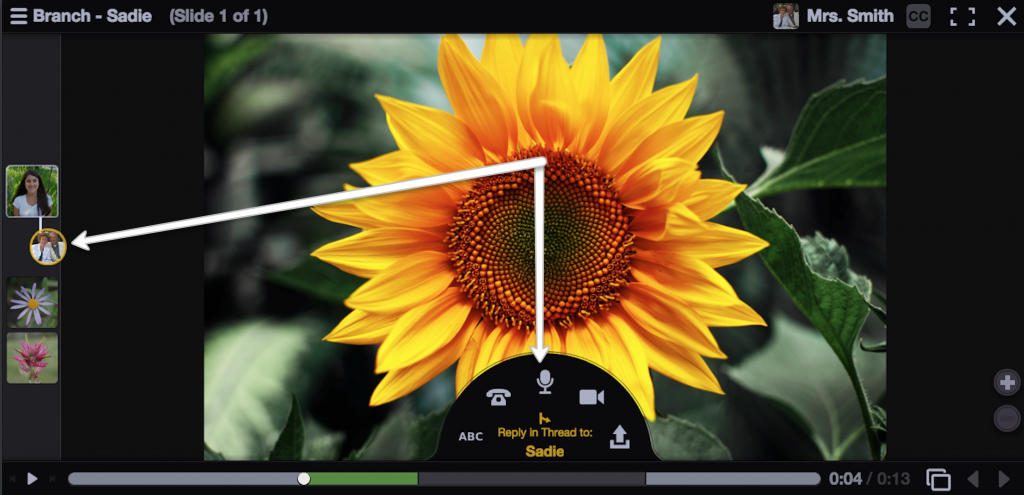
After you have saved your comment, you’ll see that new comment appear in the conversation channel. As more people contribute to the threaded conversation, you’ll see those comments connected by a white line.

Note: There can only be one threaded conversation per root comment. If threaded commenting is enabled, then direct reply commenting is not available.
*Free-account holders cannot enable threaded commenting on their own VoiceThreads.
Let us know what you think in the comments below!








This is a guest post by design instructor and VoiceThreader, Jody Lawrence.
I integrated VoiceThread into my freshman design studio to facilitate instructor and peer critiques, and to promote student dialogue and networking with practicing designers around the country. The students embraced the technology as an enhancement to their in-person studio experience, sharing that the tool introduced continuity to their learning throughout the week, and improved the quality of scheduled, in-class time. As an unexpected outcome, implementing this online tool subsequently transformed how students seek instructional and peer feedback about their design solutions. My experience suggests that VoiceThread has benefits that extend beyond its use as an effective method for design critique, and serves to complement the rigor of a traditional design studio.
If you are reading this blog, you already have an idea about the impact that VoiceThread is making to education. VoiceThread is dissolving the walls of traditional learning environments, enhancing the educational experience for educators and learners alike. I set out to explore VoiceThread as a change agent within my own discipline; design. The experience resulted in engaging students in unexpected and positive ways, and it expanded my beliefs about online design education. This post shares how implementing VoiceThread as method for critique has enhanced the learning experience for my design students, and the surprising results of incorporating it into my teaching.
Design studios are unique from other classrooms as spaces where solutions manifest by students engaging an in-depth process of design, involving research, discourse, and the act of making. The studio is the core to any design program. The learning that happens in studio often unfolds within the walls of the studio environment. Design studios are typically centered around in-person model of interactive scaffolding, discourse, and critiques between student and instructor. Local professionals often enter this model as visitors. Technology within this model have surfaced primarily as a means for production; presentation layout and printing, digital rendering, and modeling (physical and computer-based).
VoiceThread initially captured my interest as an online method to enhance this model, and to promote the dynamic and frequent exchange of ideas needed for design education. The program supports uploading a variety of visual media used by designers, and the built-in tools of a “thread” allow you to discuss the media in a way that mimics being present. Providing descriptive, verbal feedback about design development while drawing on images of the work is compatible with the formative assessment activities that occur in studio. These attributes make the benefits of the activity almost indistinguishable from in-person design discourse.
I first integrated VoiceThread as an online method to connect students from two sections of an interior design studio. I set up randomized, small-group threads and invited the students to voluntarily critique each other outside of class. The program readily engaged students and resulted in a high level of participation. Administering the threads allowed me to monitor and mediate the process. Controlling the activity in this way took time, but it was worth it; the initial setup proved to be a one time affair, it yielded a guided platform to introduce the technology to students, and allowed me to gain trust in VoiceThread as a critiquing platform. The critiques that ensued were meaningful, productive, and richly descriptive discussions. The students enjoyed that they could accomplish all this on their own time and gave them a virtual space to share the development of their ideas. Also, they liked having an alternative way to participate in the formative assessment of their projects. As an added benefit, monitoring the discussions allowed me to assess the application of knowledge and vocabulary of the student critics.
The experience of using VoiceThread was so positive that I extended its use to broader formative assessment with outsider visitors. These are often time consuming and difficult to organize because they traditionally occur on-site and in-person. The asynchronous attributes of VoiceThread made it easy to connect with professionals from all over the world. Rather than having to be present at a specific time and location to contribute, critics could comment at their own convenience and students could review feedback privately and repeatedly. Post-critique surveys revealed that the critiques were convenient, effective, and enjoyable. The professionals shared that VoiceThread allowed them to participate despite their geographical and scheduling constraints. The students shared a desire to have more VoiceThread critiques with professionals because it made them feel connected to industry and because the conversations were not isolated to a single afternoon.
The accretive nature of VoiceThread was an unexpected benefit to using the program. Students, instructors, and/or critics can upload additional developments of work and continue discussions as long as the thread is active. An idle thread can either be simply disregarded or exhausted by archiving it as digital video file. This longitudinal model of formative assessment to a design studio is powerful, and is useful for any project-based course. The ability to revisit any past critique is informative to both instructors and students, and promotes post-project reflection. One professional who participated in the outside critiques commented on this in the post-critique survey:
“The advantage of VoiceThread is that everyone can have a record of the development process as it happened, allowing for further study and review as well as allowing access to such information anywhere and anytime. The fact that multiple reviews from many individuals are recorded is a benefit to everyone involved in the exchange of information.”
Perhaps the most surprising benefit of implementing VoiceThread into my studio has been the after effects of introducing it to the students. I observed a decline in email communication from students shortly after the initial introductory activity, which was synchronous to an increase in student-generated VoiceThreads. Students organically adopted the tool as a primary way to solicit feedback outside of studio. One student praised the tool by sharing, “This online program allows us to view the work of other students across different sections and is allowing us to get feedback out of class without wasting valuable class time.” For design studios that meet twice a week with intervening gaps of time, the autonomy of this feedback has been a significant improvement to the fluidity of their learning. The verbal method results in far more descriptive feedback than in written form, and mimics dialogue that happens naturally in person. I believe that this is an attractive aspect to my design students. In subsequent design studios, my VoiceThread-experienced students have continued to use it as a resource that enhances their learning. I find this to be an exceptional metric.
My interest in VoiceThread started with a hunch and resulted in an instructional learning experience that allowed me to discover and witness the benefits to the traditional model of design education. VoiceThread is an effective resource for reinforcing continual and descriptive discourse during the design process, facilitating design critique, improving communication, and for broadening student exposure to industry professionals. This illustrates how design educators can readily integrate online sources into design education to enhance teaching and learning. As an area for further study, I postulate that the VoiceThread critique is comparable to its traditional, in-person counterpart; equally able to facilitate the growth of learning designers.
About the author
Jody Lawrence is a Doctoral Student at the College of Design at the University of Minnesota. Jody is an experienced design studio instructor with Master’s degrees in Architecture and Teaching. Jody’s scholarly interests stem from a diverse integration of disciplines, including teaching and learning, architecture and design, and the integration of online platforms. She is currently developing research that examines school contexts that foster creative instruction. She is also collaborating on several projects that explore online technology as a catalyst for extending the traditional design studio.

































